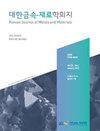锗、铟双掺杂对闪辉石热电性能的影响
IF 1.4
4区 材料科学
Q4 MATERIALS SCIENCE, MULTIDISCIPLINARY
引用次数: 0
摘要
cu3sb1 - x - ygeexinyse4(0.02≤x≤0.12;0.04≤y≤0.08)掺杂Ge和In的透辉石化合物采用固态合成方法制备。分析了材料的物相和微观结构,并根据Ge和In的掺杂量评价了材料的电荷输运和热电性能。大多数样品含有单相四边形结构的透辉岩;x = 0.12, y = 0.08时,样品中检出了Cu0.875InSe2、In2Se3和InSb等次生相。掺入Ge和In均增加了透辉石的a轴和c轴晶格常数,分别为a = 0.5651 ~ 0.5655 nm和c = 1.1249 ~ 1.1255 nm,但掺杂量的变化对晶格常数的影响不显著。Ge和In双掺杂样品的熔点为736 K,低于纯Cu3SbSe4的熔点(741 K)。熔点的降低是由于形成了固溶体。电导率表现为简并半导体行为,随温度升高而降低。随着Ge和In掺杂量的增加,载流子浓度和电导率增加;而当x≥0.12时,电导率没有进一步提高。塞贝克系数表现为正值和p型传导特性。此外,在测量温度范围内没有发生本征跃迁,塞贝克系数随掺杂水平的增加而增加。功率因数与温度呈正相关,在623 K时Cu3Sb0.86Ge0.08In0.06Se4的功率因数最高,为0.89 mWm-1K-2。随着温度的升高,由于晶格导热系数降低,电子导热系数略有增加,导热系数有降低的趋势。所有样品在523 K时的最小热导率为0.94 ~ 1.11 Wm-1K-1。在高温下,Ge和In的双掺杂改善了热电性能;因此,在623 K下得到Cu3Sb0.86Ge0.08In0.06Se4的无因次优值为0.47。本文章由计算机程序翻译,如有差异,请以英文原文为准。
Effects of Double Doping Germanium and Indium on the Thermoelectric Properties of Permingeatite
Cu3Sb1–x–yGexInySe4 (0.02 ≤ x ≤ 0.12; 0.04 ≤ y ≤ 0.08) permingeatite compounds doped with Ge and In were prepared using solid-state synthesis. The phases and microstructures were analyzed, and the charge transport and thermoelectric properties were evaluated according to the Ge and In doping content. Most of the samples contained a single phase of permingeatite with a tetragonal structure; however, secondary phases (Cu0.875InSe2, In2Se3, and InSb) were detected in the samples with x = 0.12 and y = 0.08. Both the a-axis and c-axis lattice constants of permingeatite were increased by Ge and In doping, with a = 0.5651–0.5655 nm and c = 1.1249–1.1255 nm, but the change in lattice constant due to the change in doping amount was insignificant. The melting point of the sample double-doped with Ge and In was determined to be 736 K, which was lower than the melting point (741 K) of pure Cu3SbSe4. This lowering of the melting point was attributed to the formation of a solid solution. The electrical conductivity exhibited degenerate semiconductor behavior, decreasing with increasing temperature. As the Ge and In doping content increased, the carrier concentration and electrical conductivity increased; however, when x ≥ 0.12, the electrical conductivity did not increase further. The Seebeck coefficient exhibited positive values and p-type conduction characteristics. In addition, intrinsic transitions did not occur in the measurement temperature range, and the Seebeck coefficient increased as the doping level increased. The power factor exhibited a positive temperature dependence, and Cu3Sb0.86Ge0.08In0.06Se4 exhibited the highest value of 0.89 mWm–1K–2 at 623 K. As the temperature increased, the thermal conductivity tended to decrease because of the decreased lattice thermal conductivity and slightly increased electronic thermal conductivity. All the samples exhibited minimum thermal conductivities of 0.94–1.11 Wm–1K–1 at 523 K. At high temperatures, the double doping of Ge and In improved the thermoelectric performance; thus, the dimensionless figure of merit obtained at 623 K for Cu3Sb0.86Ge0.08In0.06Se4, was 0.47.
求助全文
通过发布文献求助,成功后即可免费获取论文全文。
去求助
来源期刊

Korean Journal of Metals and Materials
MATERIALS SCIENCE, MULTIDISCIPLINARY-METALLURGY & METALLURGICAL ENGINEERING
CiteScore
1.80
自引率
58.30%
发文量
100
审稿时长
4-8 weeks
期刊介绍:
The Korean Journal of Metals and Materials is a representative Korean-language journal of the Korean Institute of Metals and Materials (KIM); it publishes domestic and foreign academic papers related to metals and materials, in abroad range of fields from metals and materials to nano-materials, biomaterials, functional materials, energy materials, and new materials, and its official ISO designation is Korean J. Met. Mater.
 求助内容:
求助内容: 应助结果提醒方式:
应助结果提醒方式:


